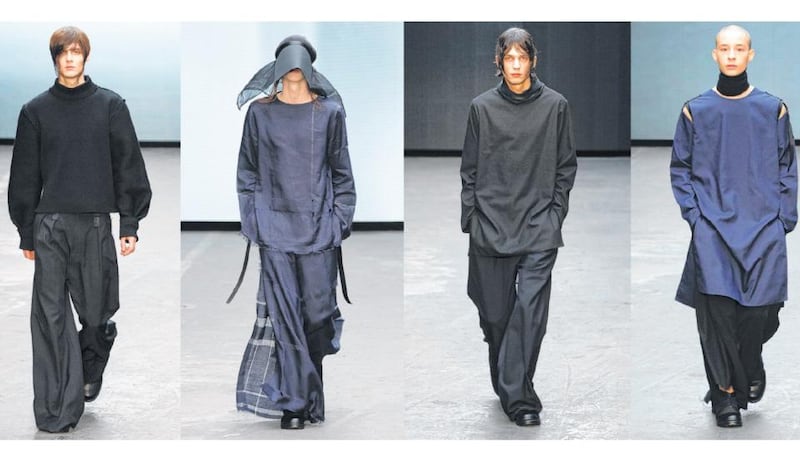One of the rising stars of modern menswear is young London-based Galwegian Rory Parnell Mooney, a man with an intriguing surname and an arresting appearance.
Mooney is part of a widening group of Irish fashion talent in London. He graduated with an MA from Central Saint Martins last February and already his collection is being stocked in the Dover Street markets in London and New York, in H Lorenzo in Los Angeles, and in Nowhere on Aungier Street, Dublin.
We meet at an autumn-winter menswear fashion presentation at Nowhere during one of his rare visits to Ireland. He is attending with another successful British menswear star, Royal College of Art graduate Matthew Miller. Mooney, who is clad head to toe in black, presents an almost monastic appearance with his shaved head, floppy wide-leg trousers and a surplice-like tunic. Ecclesiastical dress, it turns out, has always fascinated the designer. It's an obsession fuelled by Faith, photographer Jackie Nickerson's compelling portraits of Catholic religious orders in Ireland, not to mention Moonye's own education by the Jesuits in Galway.

His collection has been described as a mix of the sacred and the seditious. “I have always loved the ritualistic elements of the church, and what I am interested in is setting the fine line between an obsession with things that are beautiful and take a long time to make and yet still trying to make them cool and relevant. So everything is made with the precision of this elegant ritual and at the same time working against that like angry teenage kids,” he says, describing his dark robes with their ragged edges and sinister-looking headgear.
Obsessed with perfection
He speaks relentlessly about being “obsessed” with perfection. “I have been trying to make the same outfit again and again and make it perfect. I want to see how every toile [a version of the finished garment] fits. We will toile a jacket 20 times because I want to see it on people.”
Such striving for improvement makes him a hard taskmaster, but it results in well-engineered garments that look deceptively simple. There is minimal stitching and edges are deliberately ragged, but tightly top-seamed jacket pockets are cleverly slashed into triple-layered, bonded Melton wool and the threads in a navy linen tunic have been laboriously pulled to create a check effect in the fabric. Whatever about the ritualistic elements of the church, the devil is in the detail.
He must have cut quite an appearance even as a kid? “I grew up in Salthill and used to wear wide-leg jeans to school. The Jesuits in Galway don’t have a uniform, and I remember going in on the first day wearing these massive jeans with pockets and chains and all these kids were wearing Hollister hoodies and tees. I was always the outsider from then on and used to rip my jumpers as a teenager,” he says.
His parents, and particularly his mother, Sarah Parnell, an English radiologist, allowed him complete freedom of expression growing up. “We used to trawl around churches in France and were dragged around art galleries rather than beaches, and the only thing I was good at in school was art and music.” He played violin and cello, was part of a youth orchestra and sang in church choirs – another influence, he reckons, on his later attitude to churchly ritual and ceremony.
After school he moved to London and did a foundation year with the London College of Fashion. He started his BA in 2008 with the late Prof Louise Wilson and went straight on to do a master’s degree in 2012, funding his education by working four days a week in restaurants. He continues to teach in Central Saint Martins. This helps to finance his collections, which are made in his studio in Dalston.
His approach to fashion mirrors that of Japanese designers such as Yohji Yamamoto, whose focus is the space around the body. “Comfort is very important to me. I like things that are clean and minimal but I love a lot of fabric. You can still wear Yohji stuff from the 1980s; it ages so well and his work is a continuous line from that time, and still valid, only more refined and with better fabric.
“Menswear is interesting now because there is so much more to be explored. Men are coming around to the idea that a top with shell beading, for example, is not a bad thing, and young menswear buyers are fuelling this [trend] and buying more interesting things. I want my brand to be quiet, assured and humble.”
Let us pray that it continues to be.








